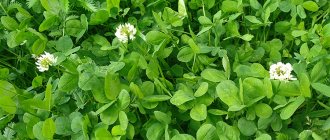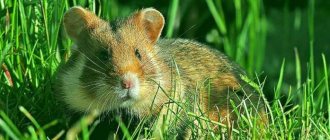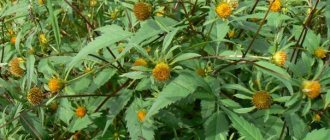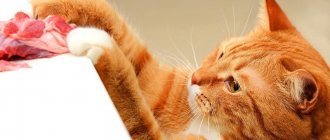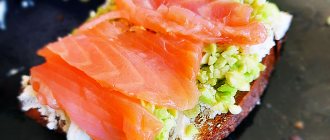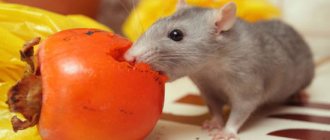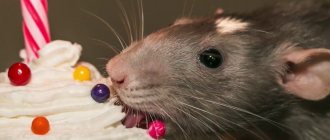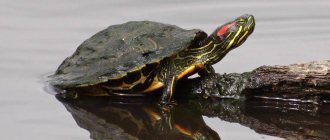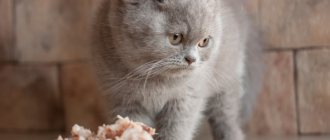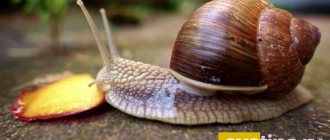Rabbits are exclusively herbivorous mammals. Therefore, their diet should consist of useful vegetation as much as possible. The green “menu” should be given special attention. Not all plants are useful, and some can simply lead to the death of animals. Therefore, rabbit breeders should be well acquainted with which greens are acceptable and which ones should not be fed to their pets.
Beneficial properties of herbs
In spring and summer, green food is the main food for rabbits. It is juicy, contains a lot of water, but also contains all the nutrients rabbits need: complete proteins, simple carbohydrates, minerals, vitamins, enzymes, some fats, chlorophyll. Plus, grass is always available and free.
Young grass is comparable in nutritional value to concentrates, and surpasses them in biological value. On average it contains:
- proteins – 20-25%;
- nitrogen-free substances – 30-60%;
- fat – 4-5%;
- fiber – 10-15%;
- minerals – 9-11%.
Many plants suitable for rabbits' food are found everywhere. For example, the most common dandelions increase appetite, contain a lot of protein, but at the same time little fiber. It is best to give them not separately, but together with other herbs in a volume of 30% of the total amount.
Siberian hogweed (leaves only) is useful to feed to lactating females to increase milk production. Nettle will provide the body of rabbits with protein and vitamins; it can be used for stomach disorders and hemorrhages, as an antimicrobial agent (in this case, leaves are used, which are collected at the end of the first or at the beginning of the second summer month) and as a milk extractor. Nettle is fed 2-3 times a week, given fresh (scalded with boiling water, dried, crushed and sprinkled with dry food). Stems with leaves (without flowers) are prepared for the winter: dried in the shade and stored along with the rest of the hay in an unlit and dry place.
Coltsfoot can also be fed either fresh or dried. It is especially useful for diseases of the stomach, lungs and bronchi, and normalizes digestive processes.
Common wheatgrass, which grows everywhere, has high nutritional value and has a diuretic effect. Plantain contains a lot of vitamins and protein and has a wound-healing effect. Wormwood not only increases appetite, prevents gastric disorders, but also helps rabbits get rid of worms. However, its share in the total diet of green food for animals should not exceed 40% (due to the likelihood of nervous excitement).
Many plants, such as yarrow, burdock, plantain, and onion, contain phytoncides that help fight infections.
Type of food
You should not feed your pet one specific type of grass for a long time. It is best to form a kind of herbal complex, collected from various species.
By using fresh grass feed, rabbit breeders must understand their benefits, and they are quite obvious:
- A minimum amount of money and time is spent on harvesting herbs.
- Savings on the purchase of dry food and grain crops due to the use of green mass.
- The stems and leaves of legumes contain many amino acids and proteins. And they contribute to the rapid growth and gain of live weight of animals.
In autumn and winter, there is a shortage of green grass. Therefore, many inexperienced rabbit breeders may immediately have a question: how to feed their pets grass? At this time, succulent food should be introduced into the diet, namely vegetables and silage (special canned food for rabbits). This type of food is easy to digest, it is quickly absorbed, and has a positive effect on digestive processes, as well as on lactation.
Closer to spring, hay reserves usually come to an end; for this period it is necessary to prepare branch feed. To do this, at the beginning of summer, young branches are cut from various deciduous trees, tied into brooms and dried in a ventilated room.
You can include the following succulent foods in your eared menu:
- red and yellow carrots. This vegetable is an essential source of carotene, vitamins B and C, all of these components are necessary for the body of rabbits in the winter;
- fodder cabbage. The vegetable contains a high level of vitamin K, protein, as well as mineral elements - calcium, sulfur, phosphorus, iron;
- You can give beets fresh or dried. Sugar beets are well digestible. But this vegetable crop should be given in limited quantities;
- Sometimes rabbits can be fed potatoes. But since it contains a high level of starch, it is recommended to boil the vegetable;
- Be sure to additionally feed the animals with pumpkin, watermelon, and zucchini.
Rabbits are very fond of raspberry and linden, alder and rowan branches. Plants such as apricot, buckthorn, elderberry and bird cherry cannot be used. The branches of these trees contain toxic substances and can harm your pet.
You can give your rabbit branches from the following trees:
- Maple
- Apple tree
- Rowan
- Ash
- Mulberry
- Grape
- Acacia
- Raspberries
Sometimes you can feed branches:
- Duba
- Birches
- Alders
- And you
- Coniferous trees
In the spring-summer season, when forbs are rampant, green matter in the rabbits' diet half replaces feed and cereals.
What grass can you give to rabbits?
Animals can be fed with plants grown in their own garden or collected from meadows and fields. These are types such as:
- red and white clover, sow thistle, burdock, wheatgrass, dandelion, American chamomile;
- alfalfa, lupine, vetch, sainfoin, sweet clover, peas, meadow china, ryegrass, mouse peas and many other legumes;
- oats, wheat, rye, corn, brome, millet, sorghum, bluegrass, barley, sudanese, timothy and other cereals;
- rapeseed, rapeseed, mustard;
- knotweed, amaranth and amaranth, garden sorrel and horse sorrel;
- phacelia;
- woodlice, shepherd's purse, quinoa, yarrow, chicory, goat's rue, mallow and even sedge and reed.
Rabbits also eat weeds left after weeding the garden and thinned out grown vegetable plants. Animals will be delighted if you offer them: tops of celery and carrots, rhubarb, radishes, turnips, rutabaga, parsnips, leaves and stems of Jerusalem artichoke and sunflower.
Leaves of beet, sugar, red, fodder can be given, but in limited quantities due to the laxative effect inherent in plants on the rabbit’s body. It is useful to feed the tops not separately, but together with alder or oak branches, yarrow, which have astringent properties. You can also give greens: parsley, spinach, cumin, dill, as well as branches of fruit trees, hazel, birch, willow, etc.
There is a conflicting opinion about whether it is possible to give rabbits milkweed, which has a milk-producing effect. Some rabbit breeders claim that due to the content of euphorbin, a toxic substance that disrupts digestion, the grass leads to heart failure and convulsions. Others say that poisoning only occurs when overfeeding.
Often those who keep rabbits as pets are interested in what types of grass can be given to decorative rabbits. They can be fed with the same plants as animals of ordinary breeds, but they must be given in small portions, in a mixture, and not as a single component, and monitor how the animal’s body reacts to them.
Green food on your site
Experienced owners know what kind of grass can be fed to rabbits, and while weeding the beds, they set aside removed weeds, as well as thinned vegetable crops, and the remains of pruned branches of fruit trees. It can be:
- Nutritious legumes.
- Oats, which can actually be sown twice per season. To do this, the second batch must be planted immediately after the first mowing.
- Borage, which is very useful for those with long ears, requires deep planting.
- Green peas are used for food in the dried form of stems and pods.
Clover grows well and quickly after planting. Another plant for a summer cottage is considered cultivated alfalfa. Rabbits simply adore it, and it is easy to grow, since the crop can withstand any climatic conditions.
Medicinal herbs
Among the medicinal plants you can find those that will also be useful for rabbits. Animals can be fed plantain rhizomes and leaves, mint, sage, tansy, fireweed, lemon balm, coltsfoot, licorice, etc. Little by little (no more than 30% of the total green food ration) is added to regular grass to diversify the diet. and improving the health, coat and taste characteristics of meat throughout the life of the animals. Motherwort, although not poisonous to animals, is not recommended to be fed in large quantities.
Harvesting and feeding of beneficial herbs for rabbits is carried out not only at the beginning of the plant growing season, but practically throughout the warm season, until autumn. Before feeding, fresh grass must be dried. For the winter, dry in the shade and store in a dry and unlit place.
We recommend reading
Is it possible to give rabbits burdock, feeding norms
What kind of sorrel can be given to rabbits, in what quantities?
The benefits of alfalfa for rabbits, feeding rates
Rules and regulations for feeding rabbits with fresh cucumbers
Photo gallery
Photo 1. Rabbit chews parsley
Photo 2. Rabbit nibbles rosehip leaves
Photo 3. A rabbit chews a dandelion leaf
Poisonous herbs
It is noted that even harmful plants, if they are withered and dried, partially lose their toxic properties. Therefore, if some herbs are found among the forbs in a new place, the food should be given not fresh, but after drying.
Definitely, in any form, you should not give the following grass to rabbits:
- common datura;
- poisonous buttercup;
- belladonna;
- horned cornflower;
- white hellebore and Lobel's hellebore;
- intoxicating tares;
- ambrosia.
Poisonous grass for rabbits also includes:
- common thorn;
- vekh poisonous;
- black henbane;
- nightshade;
- raven eye;
- cockle;
- spotted arum.
Poisonous plants for rabbits can be:
- anemone;
- Ivan-da-Marya;
- swamp whitewing;
- autumn colchicum;
- wrestler (wolfsbane);
- marsh marigold;
- larkspur.
Rabbits should not be given potato tops and some plants considered medicinal, for example, hemlock, celandine, auranium officinalis, foxglove, lily of the valley, poppy and St. John's wort, horsetail. Even in small quantities they can cause poisoning, disruption of many organs, paralysis and death of animals.
Basic rules and norms of feeding
Do not feed wet grass to rabbits: after rain or with dew, just cut and warm. It easily causes bloating in animals. Any fresh plants should be dried before distribution. Avoid feeding rabbits with low-quality grass and hay: moldy, rotten, rotten, dirty.
You should not feed greens collected along the edges of large and busy highways - the dust and exhaust gases they contain can lead to digestive disorders. The same applies to weeds collected from the garden after treating the beds with agrochemicals.
The most nutritious grass is young, harvested before the flowering period, then it becomes coarser, the content of useful substances in it gradually decreases, and fiber, on the contrary, increases. Legumes can be mowed during the period of budding and the beginning of flowering
You can feed rabbits in the summer with a mixture of any garden and meadow plants; they can be a good replacement for juicy and roughage food, but their total amount should be no more than 30-40% of the total feed.
The diet should be varied: weeds and meadow herbs, tops should be combined with vegetables, grain mixtures, and animal feed. Introduce new plants into the menu gradually, over about a week, and in small portions.
On a day, rabbits can eat:
- succulent females – 0.8-1 kg of grass;
- female rabbits with babies – 1.2-1.5 kg;
- single females – 0.8 kg;
- baby rabbit up to 3 months – 0.25-0.5 kg;
- from 3 to 6 months – 0.5-0.9 kg.
In the spring, when switching from a winter diet to a summer one, grass should be introduced into the menu gradually, over 1-1.5 weeks (50-60 g per day).
Expert advice
Advice from experienced specialists who have been breeding rabbits for many years will help you better understand what can be given to rabbits and what absolutely cannot be given.
- The basic rule is not to feed your eared animals raw grass! Wet greens collected after rain in the summer still need to be washed and dried.
- You should not give your eared plants ornamental plants, such as poppies, buttercups, lumbago, jasmine flowers, and other flowers.
- If possible, grass should be torn off by hand, as contact with the mower causes it to oxidize.
- You cannot pick various plants near roads, on the roadway, or along the street.
- Rabbits, of course, eat lawn grass, but it is not healthy, so you should not feed them this way.
- Try to prepare food and make sure you don’t accidentally come across plants that are poisonous to long-eared animals. These are celandine, nightshade, marsh horsetail, wild mustard and radish, datura, and hemlock.
